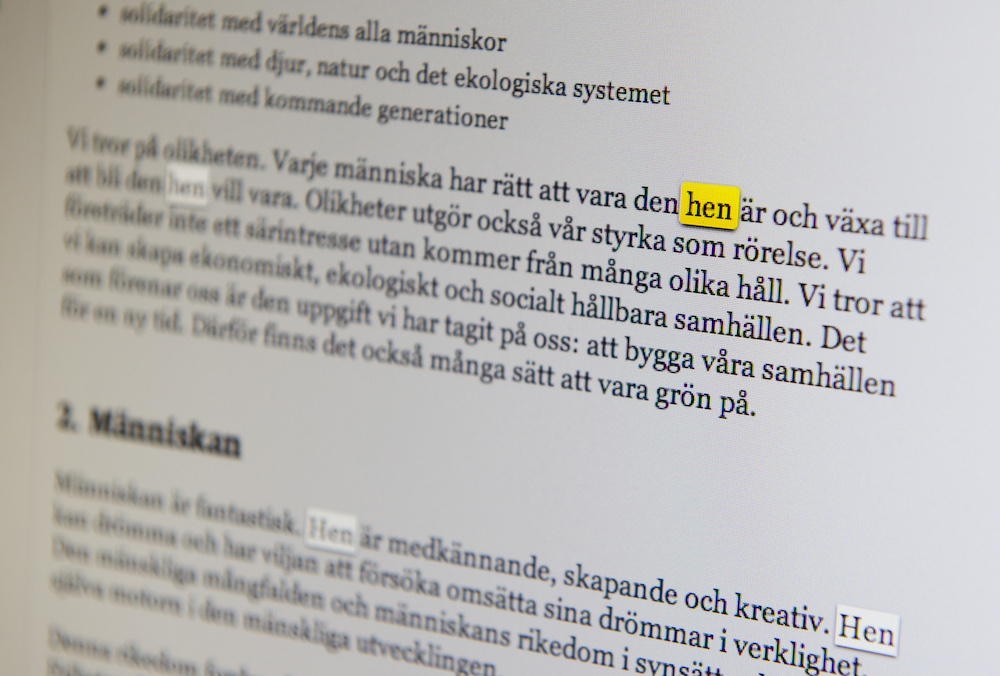Why English Might Let Go of “He” and “She”

Adapted from “Pronoun Trouble: Notes on Radical Gender Inclusion in English,” in Queer Anthropology: Critical Genealogies and Decolonizing Futures, edited by Margot Weiss (forthcoming from Duke University Press). Used by permission.
Pronouns are giving us trouble.
English speakers face a dilemma. The current structure of our language is exclusionary with regard to gender: The personal pronouns “she” and “he” don’t represent all the ways people see themselves. Having only these two options excludes trans individuals, those who identify as nonbinary, and others who don’t identify as female or male.
One popular current solution is to express preferred personal pronouns: Someone explains, verbally or in writing, a preference for she, he, they, and so on (for clarity, I’ll underline the pronouns discussed in this piece). This is a vast improvement over nondeclaration, but it has limitations. Personalized gender pronouns don’t fundamentally challenge gender exclusion; in some respects, they further it.
The more radically inclusive option is to eliminate preferred personal pronouns (including she and he) in favor of a nongendered or epicene pronoun (the word “epicene” comes from a root meaning “common”). An epicene pronoun doesn’t mark gender. For instance, in English you isn’t a feminine or masculine pronoun; it’s an epicene pronoun. I think the best replacement for he and she is they.
To be clear, I’m proposing turning English into an epicene language, altering it structurally, at its “root,” rather than tweaking the “leaves” of individual speakers. This would mean scrapping he and she altogether in favor of they, rather than picking and choosing based on circumstance or preference.
This might sound difficult. But there are plenty of other languages that already do this. English itself has made similar alterations in the past, and there are signs that the shift is already happening without anyone particularly noticing or complaining. English is actually very nearly gender neutral. All it needs is one final push to get it over the line.
Language isn’t just a set of labels to identify things: It shapes how we see the world and is a way of acting in the world. Nor is it static: It changes with shifting times. We must now intentionally transform English to make it gender inclusive.
As a queer and linguistic anthropologist, I’m inspired by social movements, from feminism to disability justice, that have changed language for everyone.
The word Latinx, for example, emerged in the English language around 2004 as a gender-neutral replacement for the Spanish “Latino” and “Latina.” “Chairman” has become “chairperson.” The word “disabled” is now preferred over historical terms such as “crippled.” These shifts have not generally been seen as a matter of individual preference but rather a pervasive language change, even if the specific words used are contested.
Read more from the archives: “Stop Erasing Transgender Stories From History.”
I also draw inspiration from other cultures and languages. The breadth of ways in which pronouns differ from one language to another shows that a lot of things English speakers might take for granted aren’t necessarily the only way of doing things.
All languages have first-person, second-person, and third-person pronouns (like I, you, and she). And all languages distinguish between some singular and plural pronouns (like I versus we)—but not always all of them everywhere in the language. For example, English doesn’t mark singular versus plural in the second-person pronoun: We use you to refer to one person or several people, regardless of number or gender.
But not all aspects of personal pronouns are universal. Some languages have a “dual” pronoun specifically for two people. For instance, in Hawaiian ‘oe means you spoken to one person (singular), ‘oukou means you spoken to three or more people (plural), and ‘olua means you spoken to exactly two people (dual).
Languages can have distinct “inclusive” and “exclusive” first-person plural pronouns. If I was at George’s house with Asya and Kim, and wanted all four of us to shop, I’d tell George, “We should go to the store.” If I wanted to shop with Asya and Kim but thought George should stay home, I’d also tell George, “We should go to the store.” In Indonesian (which I speak), I’d use the inclusive pronoun kita in the first instance but the exclusive pronoun kami in the second.
Informal versus formal status is sometimes marked on personal pronouns, like tu/vous in French, or du/Sie in German. In English, we can mark social status with words like “Sir” or “Madam,” but we can also avoid it with you: If you met a celebrity, you would say, “Nice to meet you,” using the same pronoun as when telling a child, “I love you.”
None of these three examples of personal pronoun features are universal; English works fine without them.
History plays a role. In English, there used to be a distinction between thou and you as singular versus plural pronouns. Through a historical process, you additionally became honorific, and thou came to imply lower status: Challenges to class hierarchy led to the loss of thou (save a few specialized uses). You replaced thou as the singular second-person pronoun while keeping its plural meaning: That’s why we use a plural verb even when telling one person, “You are late”—not “You is late.”
Gendered pronouns, too, aren’t universal. This is absolutely pivotal. If something is linguistically universal, getting rid of it is likely impossible. It’s hard to imagine a language without a first-person pronoun like I, for example. But if something doesn’t appear in some languages, that proves it’s not obligatory for cognition and communication.
Many languages already have no gendered pronouns. For instance, in Indonesian, dia refers to men, women, and trans people. There’s no equivalent to she or he at all. Other examples of what I call “epicene languages” include Chinese, Finnish, Japanese, Korean, Persian, and Turkish. (In modern Chinese, the pronouns for “he,” “she,” and “it” are written differently but pronounced the same when spoken in Mandarin and most other dialects.) Around 1.5 billion people speak epicene languages every day.
Some languages are more gendered than English, marking gender on nouns and adjectives: for example, Spanish and French. A few even mark gender on verbs—for instance, the past tense in Russian. Fortunately, English is already epicene with regard to nouns, verbs, and adjectives; all that remains is to extend this to pronouns. Still more fortunately, English pronouns are already epicene in the singular first person (I), plural first person (we), second person (you), and plural third person (they).
Some complain that they is plural, but we have no trouble with you as both a singular and plural pronoun.
English speakers have been using epicene they as a stand-in for he/she since the 1300s—in everyday speech and in literature from Jane Austen to William Shakespeare: “There’s not a man I meet but doth salute me as if I were their well-acquainted friend.”
Every English speaker reading this already uses epicene they, usually without realizing it (indeed, even if they think it’s wrong), and despite the discouragement of educational systems, in utterances such as “somebody left their coat in the room.” There’s strong evidence that epicene they is already displacing sexist generic he (which encodes patriarchy) and phrases like she or he (which encodes gender binarism).
In recent decades, the use of epicene they has been increasing in scholarly publications and everyday speech—even when the person mentioned has a known binary gender, as in “Professor Jones said they canceled the test.” In 2019, the American Dialect Society voted epicene they “Word of the Decade”; that same year, the Merriam-Webster Dictionary recognized epicene they. Many contemporary queer, trans, and feminist scholars, activists, and allies have also called for epicene they.
Of course, they isn’t the only option for a gender-neutral third-person singular pronoun, and it doesn’t come without issues.
Some claim epicene they is incorrect because they is plural, but we have no trouble with you as both a singular and plural pronoun.
From a feminist perspective, one possible concern is that epicene they could become a new masculine generic pronoun, erasing the impact that can be made by using she as a generic term instead of he. However, generic she hasn’t been inclusive for many people (such as many queer women, Black women, and others historically excluded from full womanhood).
Many people (including but not limited to trans people) feel a need to choose their pronouns. For over a century, this has sometimes included inventing new words entirely: neo-pronouns like em or ve. I’d ask such people to consider how this need is shaped by language itself. Why is there no desire for personalized you or I pronouns, for example? This is an English-centric feeling. Were you speaking Indonesian, Turkish, or Chinese, you wouldn’t feel a need to choose gendered personal pronouns because such pronouns don’t exist. The issue isn’t self-expression but where in language that self-expression takes place.
Sometimes the act of expressing a pronoun preference or asking for preferences is a way for someone to firmly indicate that they support gender inclusion. This is sometimes dismissed as virtue signaling, but it can be an important way to disrupt norms. This disruption is important; the question, again, is where in language that disruption best takes place.
Personalized gender pronouns require stating one’s preferences over and over again. They provide no help when referring to people we haven’t met; misgendering and its accompanying trauma are still very possible. Note how in English, the negative consequences of misgendering never occur when using first-person or second-person pronouns, because I and you are already epicene.
The whole point of pronouns is that they categorize: They group people together. Remembering many personalized gender pronouns is hard and can be ableist with regard to those with cognitive differences.
Radical gender inclusion demands completing the historical transformation of English into an epicene language by eliminating, not increasing, the marking of gender.
If we’re interested in eliminating structural oppression, then structural change is necessary.
This idea has been pivotal to other social justice movements. Racism, for instance, is recognized as not just the result of individual racist feelings but the structural consequence of a system of social relationships embedded in power and history. Similarly, heterosexism isn’t just the result of individual feelings of homophobia: It’s the structural consequence of a system of social relationships that legitimates only some forms of desire. Gender exclusion in language is also structural and requires a structural change to English to address it.
Given that English is already almost epicene, the change is comparatively easy. The change has been possible in languages with more pervasive gender pronouns: In Swedish, for instance, since 2012, the Finnish pronoun hän (epicene they; Finnish has no he or she) has inspired the Swedish hen to replace she (hon) and he (han).
Linguistic inclusion doesn’t automatically mean social inclusion: The fact that we use “humankind” instead of “mankind” doesn’t mean sexism no longer exists. But language does shape thought—in a sense, it constitutes thought, shaping our assumptions about the world and influencing how we act in everyday life.
Giving up she and he might seem painful. But at one point, thou was equally well-known; over time, it was eliminated without detriment. I ask English-speaking cisgendered allies to give up she and he in the name of radical gender inclusion.
I look forward to the day when she and he are like thou: archaic pronouns recognized in old texts but no longer in common use. There is a path out of this pronoun trouble.
Correction November 23, 2021
An earlier version of this article implied that all forms of modern Chinese (written and oral) evidenced an epicene language. The text has been updated to indicate that the written pronouns “he,” “she,” and “it” differ in modern Chinese, but when spoken in Mandarin and most other dialects, they are pronounced the same.
Correction June 28, 2022
An earlier version of this article referred to “inclusive” and “exclusive” third-person plural pronouns, but the examples are of first-person plural pronouns.
































